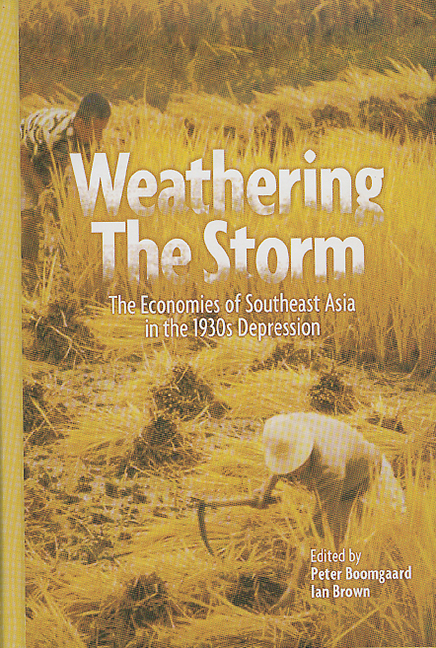Book contents
- Frontmatter
- Contents
- List of Tables
- List of Figures
- Acknowledgements
- List of Contributors
- 1 The Economies of Southeast Asia in the 1930s Depression: An Introduction
- PART I MATERIAL CONDITIONS
- 2 Surviving the Slump: Developments in Real Income During the Depression of the 1930s in Indonesia, Particularly Java
- 3 The Philippines in the Great Depression: A Geography of Pain
- 4 Uneven Impact and Regional Responses: The Philippines in the 1930s Depression
- 5 Material Conditions in Rural Lower Burma During the Economic Crisis of the Early 1930s: What the Cotton Textile Import Figures Reveal
- PART II AGRICULTURAL STRATEGIES
- PART III TRADING COMMUNITIES
- PART IV THE STATE'S RESPONSE
- Index
3 - The Philippines in the Great Depression: A Geography of Pain
from PART I - MATERIAL CONDITIONS
Published online by Cambridge University Press: 21 October 2015
- Frontmatter
- Contents
- List of Tables
- List of Figures
- Acknowledgements
- List of Contributors
- 1 The Economies of Southeast Asia in the 1930s Depression: An Introduction
- PART I MATERIAL CONDITIONS
- 2 Surviving the Slump: Developments in Real Income During the Depression of the 1930s in Indonesia, Particularly Java
- 3 The Philippines in the Great Depression: A Geography of Pain
- 4 Uneven Impact and Regional Responses: The Philippines in the 1930s Depression
- 5 Material Conditions in Rural Lower Burma During the Economic Crisis of the Early 1930s: What the Cotton Textile Import Figures Reveal
- PART II AGRICULTURAL STRATEGIES
- PART III TRADING COMMUNITIES
- PART IV THE STATE'S RESPONSE
- Index
Summary
Study of the economic history of Southeast Asia is coming on these days. Even so, work on the impact of global trade cycles remains underdeveloped, and critical attention to the historical geography of such phenomena has barely begun. This essay is an attempt to compare regions and provinces of the Philippines in terms of the economic experience of the vulnerable strata of society during the depression of the 1930s. My purpose is to develop an analytical framework for the exploration of the sub-national impacts of the slump and then, in essence, to map the depression in space and time. The differences among places are strongly traceable to the profile of local cash crop specialization and to the market demand and political economy surrounding each crop. It is worth noting that trade cycles were not the only, or even the primary, cause of episodic economic hardship in the archipelago during the twentieth century. In a concurrent project, I have been impressed by the impact of droughts, usually but not always associated with El Niño climatological patterns, on rice production. Likewise, the diffusion of the epizootic rinderpest from the mainland so thoroughly annihilated the herd of carabao work animals at the end of the 1880s and again in the early twentieth century that a great many fields went unploughed and unplanted. There were near famine conditions in several provinces in the early 1900s. Finally, imperial warfare at the turn of the century and in the 1940s was also the proximate cause of great human suffering. In metropolitan Manila, the starvation of 1944-45 and, in living memory at least, the combination of inflation and unemployment in the Marcos depression of the mid-1980s were both more harmful than the slump of the 1930s. Trade cycles were important events from the point of view of their potential impacts on human welfare but they were hardly singular.
- Type
- Chapter
- Information
- Weathering the StormThe Economies of Southeast Asia in the 1930s Depression, pp. 53 - 82Publisher: ISEAS–Yusof Ishak InstitutePrint publication year: 2001

